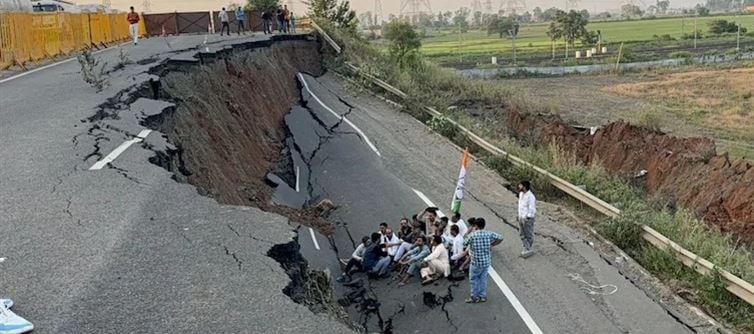
On monday afternoon, a 100-meter stretch of road caved in near Bilkhiriya village, leaving a 30-foot-deep crater and sending shockwaves across Madhya Pradesh. No vehicles were passing, no injuries were reported — but the incident revealed a deep structural failure, decades of neglect, and the murky reality of state highway maintenance.
While social media reels circulated the crumbling retaining wall, the bigger story is not the fall of asphalt, but the fall of accountability.
🕳️ 1. The Collapse in Numbers
Depth: 30 feet
Length: 100 meters
Location: Near Mandideep to Intkhedi bridge, bhopal Eastern Bypass
Roads affected: Key artery connecting bhopal to Indore, Hoshangabad, Jabalpur, Jaipur, Mandla, and Sagar
Barricades are in place, traffic is diverted, and repair work began late monday evening. But the crater’s real depth is in political and administrative negligence.
🏗️ 2. A Bridge With a Broken History
Constructed in 2013 under a Build-Operate-Transfer (BOT) model by M/s Transtroy Pvt Ltd
Contract canceled in 2020 for failing obligations
Since then, no dedicated agency has maintained the stretch, and in-house repairs have been outsourced when convenient
This is the literal and figurative foundation of collapse: infrastructure built to fail, left to decay, and now falling into public view.
⚠️ 3. The Preliminary Cause — RE Wall Failure
The Reinforced Earth (RE) wall of the Sukhi Sewania ROB appears to have failed.
Engineers are probing whether:
Improper drainage
Structural weakness
Lack of inspections
caused the disaster.
10 years of exposure, 3 years of neglect, and one afternoon later — a crater reminds us that engineering isn’t just about construction. It’s about care, oversight, and responsibility.
👷♂️ 4. The Committee That Will Decide Accountability
A three-member team has been formed:
General Manager Manoj Gupta
General Manager RS Chandel
Task: Identify the exact cause, report to the government, and recommend action.
The spokesperson warned: “If negligence or irregularities are found, strict action will be taken.”
But after a decade-long neglect cycle, one wonders: who really pays?
🧱 5. The Bigger Picture — Quality vs. Convenience
The bridge has existed for over a decade. Yet the quality of state highway construction and oversight continues to ignite debate and outrage.
Critics recall PWD minister Rakesh Singh’s statement from three months ago:
“No technology has yet been developed that can guarantee a road that will never have potholes. As long as roads exist, potholes will continue to exist.”
One can almost hear the crater laughing at this logic.
🔍 6. Neglect Isn’t Accidental
From BOT mismanagement to deferred maintenance, this collapse exposes:
Institutional gaps
Short-term project thinking
Failure to enforce accountability
It’s a reminder that roads aren’t just concrete — they’re lifelines. When these fail, citizens bear the cost — sometimes literally.
🛠️ 7. Immediate Response — Repair & Stabilization
Barricades erected
Partial closure for traffic diversion
Soil stabilization and repair work are underway
But stabilization of infrastructure is one thing. Stabilization of governance is another.
⚖️ 8. The Takeaway — Lessons Beyond Asphalt
A road collapse isn’t just an accident — it’s a warning from the past and a challenge for the future:
Build properly
Maintain consistently
Inspect regularly
Ensure accountability
Otherwise, the next crater might not wait for empty roads to appear in daylight.




 click and follow Indiaherald WhatsApp channel
click and follow Indiaherald WhatsApp channel